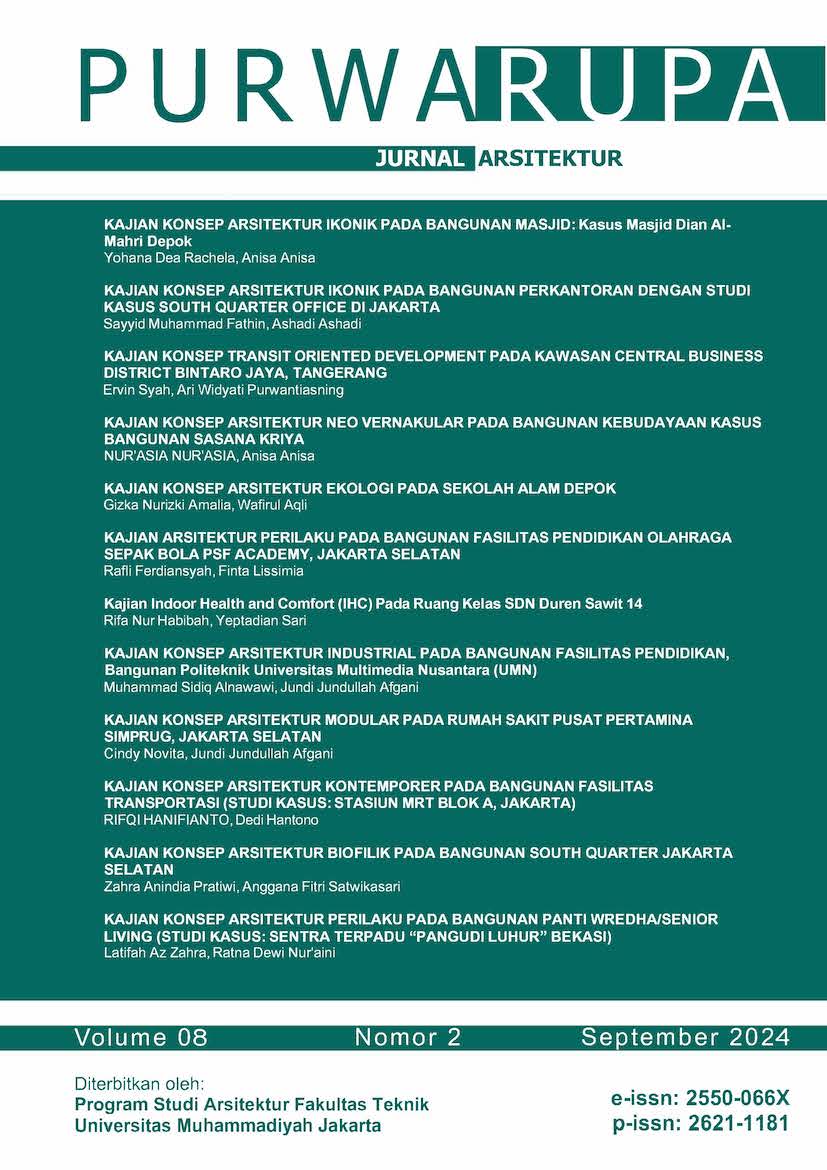KAJIAN KONSEP ARSITEKTUR INDUSTRIAL PADA BANGUNAN FASILITAS PENDIDIKAN, Bangunan Politeknik Universitas Multimedia Nusantara (UMN)
DOI:
https://doi.org/10.24853/purwarupa.8.2.143-152Abstract
ABSTRAK. Seorang arsitek bertindak sebagai perancang konsep untuk pembangunan sebuah struktur. Oleh karena itu, konsep bangunan harus dipertimbangkan secara serius oleh seorang arsitek. Salah satu konsep yang bisa diadopsi adalah konsep industrial, yang menitikberatkan pada aspek fungsional dari suatu bangunan yang akan dibangun. Konsep arsitektur industrial pada dasarnya melibatkan perencanaan mengenai bentuk, bahan, dan elemen lainnya. Penulis menggunakan metode penelitian kualitatif deskriptif dalam penelitian ini. Pendekatan ini melibatkan observasi langsung dan tidak langsung terhadap objek penelitian, kemudian menganalisis data yang terkumpul melalui observasi dan menjelaskannya dalam bentuk narasi. Tujuan penelitian ini adalah memberikan wawasan atau gambaran yang sesuai dengan realitas di lapangan mengenai konsep arsitektur industrial. Hasil penelitian ini mencakup penjelasan rinci tentang konsep arsitektur industrial pada bangunan fasilitas pendidikan politeknik multimedia nusantara. Mulai dari bagaimana bentuk bangunannya, penggunaan material pada politeknik UMN ini, penggunaan warna, hingga bagian ekspos pada bangunan, sehingga mengetahui prinsip apa saja yang di terapkan pada politeknik UMN ini yang di duga menggunakan konsep arsitektur industrial. Kata Kunci: Arsitektur, Bangunan, Fasilitas Pendidikan, Industrial ABSTRACT. An architect acts as a concept designer for the construction of a structure. Therefore, the building concept must be considered seriously by an architect. One concept that can be adopted is the industrial concept, which focuses on the functional aspects of a building to be built. The concept of industrial architecture basically involves planning regarding form, materials and other elements. The author used descriptive qualitative research methods in this research. This approach involves direct and indirect observation of the research object, then analyzing the data collected through observation and explaining it in narrative form. The aim of this research is to provide insights or descriptions that are in accordance with the reality in the field regarding the concept of industrial architecture. The results of this research include a detailed explanation of the concept of industrial architecture in the Nusantara Multimedia Polytechnic educational facility building. Starting from the shape of the building, the use of materials at the UMN polytechnic, the use of color, to the exposed parts of the building so that later you will know what principles are applied at this UMN polytechnic which is thought to use the concept of industrial architecture. Keywords: Architecture, Building, Educational Facilities, IndustrialReferences
Ljiljana Jevremovic, Milanka Vasic, Marina Jordanovic (2012). Estetika arsitektur industri dalam konteks konversi bangunan industri. Serbia: marina.jordanovic.
Miles, B. Mathew dan Huberman, M. (1992). Analisis Data Kualitatif Buku Sumber Tentang Metode-metode Baru. Jakarta: UIP.
Sofiana, Y. (2014). Pengaruh Revolusi Industri Terhadap Perkembangan Desain Modern. Humaniora, 5-2, 833-841.
Lacy, B. N. (2018). Industrial Architecture: Fallout Shelters. Creative Media Partners, LLC.
Gaweł, D. (2012). Rebirth Of Postidustrial Architecture In Polish Towns. Civil And Environmental Engineering Reports, (9).
Fauzi, A. (2019). Pendekatan Karakteristik Bangunan Modern Industrial Pada Terminal Bus Terpadu dan Pasar Modern Cicaheum. Jurnal Tugas Akhir Jurusan Arsitektur ITENAS, 9, 1–8.
Hantono, D., & Hakim, A. H. (2019). Identifikasi Elemen Fisik Ruang Publik yang Berpengaruh Terhadap Pembentukan Visual Kawasan Kota Tua Jakarta. EMARA Indonesian Journal of Architecture, 5(2), 75–79.
Risti Amini, A., Sumadyo, A., & Marlina, A. (2019). PENERAPAN PRINSIP ARSITEKTUR INDUSTRIAL DALAM PRODUKTIFITAS RUANG PADA SOLO CREATIVE DESIGN CENTER.
Muhammad Farhan Pradana, (2016). Desain Interior Mokko Factory & Coffe Bergaya Modern Industrial Sebagai Sarana Informasi Perkembangan Penerbangan Indonesia
H. F. S. Rusyda, B. I. Harsritanto, And R. Widiastuti, "Sifat Material Pada Ruang Terbuka Di Kota Lama Yang Terkait Dengan Termal," Modul, Vol. 17, No. 2, Pp. 85-88, Jan.2018.
Downloads
Published
How to Cite
Issue
Section
License
COPYRIGHT POLICY
The author(s) of an article published in the Jurnal Teknologi retains ownership of the intellectual property rights in work (s).
PUBLISHING RIGHTS
The author(s) of an article published in the Jurnal Teknologi have unrestricted publication rights. The authors give the Jurnal Teknologi the right to publish the article and designate the Faculty of Engineering Universitas Muhammadiyah Jakarta Publishing as the original publisher of the article.
LICENSING POLICY
Journal of Mechanical Engineering and Sciences is an open-access journal that follows the Creative Commons Non-Commercial 4.0 International License (CC BY-NC 4.0), which states that:

Under this license, the reusers must give appropriate credit, provide a link to the license, and indicate if changes were made. Users may do so in any reasonable manner, but not in any way that suggests the licensor endorses users or their use.
Please take the time to read the whole license agreement (https://creativecommons.org/licenses/by-nc/4.0/). As long as reusers follow the license conditions, the owner cannot withdraw these freedoms. The following components are included under this license:
 Attribution: Users must provide appropriate attribution, including a link to the license, and indicate whether or not they made any modifications. Users are free to do so reasonably, but not in a manner that indicates the licensee approves of their usage.
Attribution: Users must provide appropriate attribution, including a link to the license, and indicate whether or not they made any modifications. Users are free to do so reasonably, but not in a manner that indicates the licensee approves of their usage.
 NonCommercial: Users may not use the material for commercial purposes.
NonCommercial: Users may not use the material for commercial purposes.

